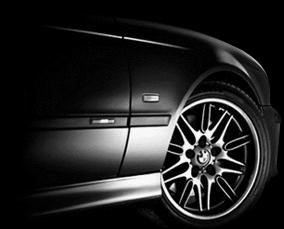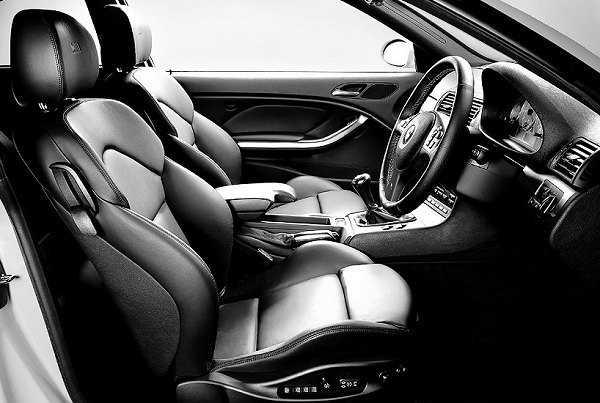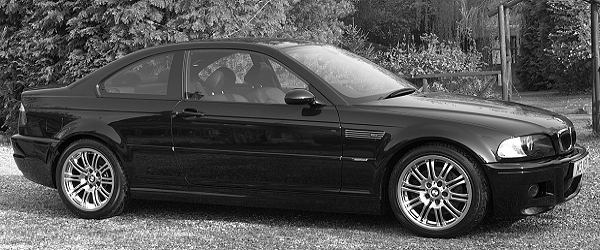THE BMW M3 E46 COUPE
...
What
the press say about the BMW M3 E46: ![]()
"Drive it for a day and you'll be amazed by the immediacy of its responsiveness and by the sheer explosiveness of its straight line performance. You'll soon start to wonder why anyone else would bother trying to build a rival to such a car" Autocar
"The selection of mechanical melodies generated by the 3.2 litre straight six engine residing under the bulging bonnet of this ultimate variation on the BMW 3 series theme tops any comparable powerplant that I've ever tuned into before" Top Gear Magazine
"BMW have launched themselves into a new class, invading Ferrari/Porsche high ground" CCC magazine
The most versatile and accomplished all-round performance car on the market" Auto Express
"The ride is a delight, look for passengers climbing out with wild eyes and puckered cheeks, or drivers wearing silly grins long after they have parked BMW's fastest-accelerating M yet". Driven
"The people who work at BMW Motorsport won't settle for second best. It shows in the M3. In the perfection of its form, the fine resolution of its details and the depth of its engineering" Evo
"This is truly a defining car for BMW. It is closer in driving character to the original M3 and delivers true supercar pewrformance" AutoCar
"A match for all but the fleetest of supercars - The quickest M car BMW have ever built" Car
"It's the pulling power that really impresses. A maximum of 269lb ft is offered at 4900rpm, which not only provides effortless overtaking potential, but also makes the M3 a doddle to drive in town, with 6th gear happy to pull from 1500rpm" What Car
Photos
of the BMW M3 E46: ![]()
for a full screen (800x600) enlargement... click on the thumbnail
The
BMW M3 vital statistics ![]()
(figures from 'Autocar')
3245cc 6 cyls in line - 343 bhp at 7900 rpm
0-30 mph 2.0 secs. 0-60 mph - 4.8 secs.
Standing quarter mile 13.4 (107 mph at 1/4 mile)
30-70 mph 4.3 secs - 60-0 mph - 2.6 secs
23.7 mpg (average)

Transmission: six-speed manual, rear-wheel drive, M-branded limited-slip differential
Suspension, front: uprated MacPherson struts with anti-roll bar, gas damping and 3mm aluminium plate load-bearing raft
Suspension, rear: central location arm, independent rear with double track control arms and aluminium upper wishbones, gas damping anti-roll bar
Brakes: three-metal-compound vented discs, ABS anti-lock braking, DSC (Dynamic Stability Control), CBC (Cornering Brake Control)
Steering: rack and pinion, power-assisted
Weight: 1570 kg
Length x width x height: 14 ft 9 in x 5 ft 10 in x 4 ft 6 in
Wheels: 18" front, 19" back magnesium alloy wheels
Tyres: 225/45 ZR (front), 255/40 ZR (rear)

Q
& A with the head of the M Division ![]()
Q: Where did BMW get the concept of using high rev engines?
A. We feel that high revs is the best way to extract every bit of potential from an engine. In F1 engines, their engines rev as high as 18000rpm, and that is the kind of performance that we are looking and aiming for; that is the origin of M-Power's high revving engine. The all new designed engine [the M3 engine] will be able to reach as high as 8000rpm, which is the highest revving production engine. These high revving engines are extremely rare. You can hardly find them before, even race cars do not have such high redlines until a few years ago.
Q. You always mention torque is very important, how is BMW managing to make torque?
A. Torque is a car's acceleration power. The more torque there is, the faster it accelerates. A high revving engine with precise internals will produce a high torque car. When you drive the new M3, you will be able to feel the power pushing you from your seat, it's really fun to drive. This feeling is not just something a typical salesman can ever tell you.
Q. Did you say horsepower is not the only measurement for acceleration?
A. Of course. You have to understand there are many ways of producing high [horse]power engines. Some car manufacturers decide to use large displacement engines, but they only have low end and no top end or even midrange. The drawback of these large displacement engines is that they are heavy, bulky, not fuel efficient, and extremely not practical. Other companies will choose to use smaller engines with higher revs, which is what M-Power is doing here. Our goal is to make smaller precise engines to lower emissions/fuel consumption. We see that as the general trend in racecars in the future.
Q. Is turbo a good way of making power/torque ?
A. A few companies like to use turbos to produce more power/torque. However, just like large displacement engines, turbos only produce low end power/torque. Besides, powerful turbo charged engines will consume a lot of fuel, more than you can imagine, and their performance will not really catch up to the performance of high revving NA engines.
Q. How would you define "response"?
A. When customers buy sports cars, they are always looking for the most direct feedback from the car. When one steps on the gas pedal, there should be no more than 0.1second of delay and the car should go right away, and that is exactly the advantage of new M-Power's high revving engines. Finally, it's also very important to have proper gear ratios and final drive gear ratio.
Q. How about in reality?
A. It's like riding a mountain bike, you can choose to use lower gears with higher revs to climb a hill. Also, you can choose to use higher gears, but you have to sacrifice to use larger displacement engines, wasting more energy. You should understand the significance of a good transmission Basically, high torque means faster acceleration, however, this is not ALWAYS the case. Torque is not the only factor of making a car go fast, a huge lawmower can produce 73.5kgm of torque (around 600lbs of torque) but with only 1400rpm redline, it cannot acclerate fast. Although the new M3 only has around half of the torque the lawnmower has, but it comes at 4900rpm. A standstill 0-100km in 5.2 seconds. F1 cars have around the same torque as M3, but the torque comes @ 13500, that's why F1 cars are even faster.
Q. How important is torque ? So based on what you said, at means a high revving engine accompanied with a properly geared transmission will lead to a superior car ?
A. BINGO. A high revving engine is the best way to extract the full potential of small displacement engines. Remember and don't forget, the displacement of an engine and a car's fuel consumption are directly proportional. When a V8 engine [talking about Camaros and Mustangs here I think] that produces about the same power as an in-line6 engine [M3] does, the V8 engine will eat up a lot more gas. However, obviously, producing high revving engines isn't that easy.
Q. How hard is it to solve the problem?
A. Everyone wants to solve this problem. However, if everyone can solve the problem [making high revving engines] then all the car manufactueres will head out that direction.
Q. Can you explain it a little more in details?
A. The amount of stress an engine has to withhold is close to F1 engines. Thats why we have to use durable and rare materials to make these engines. Just remember, F1 engines only last for one race event, but M-Power engines will last for life (forever).
Q. How do you achieve this goal ?
A. 1. we have the best engineers to design our engines 2. we use hi-tech materials to build our engines, and 3. we use distinctive machineries to produce our engines We continuously calculate and use different information to determine our engine design.
Q. Did BMW use the technology from F1 and the lessons learned from F1 engines to produce M-Power engines?
A. Of course. Although they are two different plans (one for production cars, the other for F1 cars), but they do have something in common -- the faster car wins. )

The
new Limited slip Differential Lock ![]()
Up until now, BMW M Cars have come with a torque-sensing self-locking limited slip differential with locking action of up to 25 per cent and a consistent basic locking force. Differentials are essential, of course, because the two drive wheels of a car cover distances different in length in a corner, the inner wheel not traveling as far as the outer wheel. This fundamental difference is offset by the axle differential. The limited slip differential builds up a certain locking force whenever necessary - for example when one of the two drive wheels threatens to lock on a slippery surface. Particularly enthusiastic drivers appreciate the limited slip differential since it helps them to capitalize on the positive characteristics of rear-wheel drive - above all with a sporting style of driving and on roads with a frictional coefficient ranging from average to high. A torque-sensing limited slip differential adjusts the power delivery to each rear wheel based each wheel's ability to deliver power to the road. In very low friction conditions, for example on snow, gravel or particularly smooth ice, the benefits that this conventional limited slip differential is able to offer in terms of traction are limited by the so-called slip forces beyond which the wheel loses its grip.

The M3 GT racer uses the variable M differential
The engineers at BMW M, teaming up with specialists at GKN Viscodrive GmbH, have developed an all-new differential system for the new BMW M3 - the Variable M Differential Lock. This lock offers decisive advantages in traction even in very demanding driving situations, for example when there is an extremely large difference in frictional coefficients on the drive wheels. Accordingly, the Variable M Differential Lock enables the new BMW M3, in combination with the fine-tuned DSC system and the car's perfect front-to-rear balance, to offer a standard of driving excellence and handling in winter previously regarded as quite impossible with a rear wheel-drive sports car. Maintaining Drive Power and Thrust In Every Situation A further advantage of the Variable M Differential Lock is the increase in locking forces parallel to any increase in differential speed between the drive wheels. As a result, a wheel suddenly relieved of its load and drive force - for example the inner wheel in a corner while driving fast on a mountain pass - can no longer make drive forces "collapse" entirely. Instead, drive power and the car's forward thrust are always maintained at an appropriate level.
The Variable M Differential Lock functions according to a simple principle: The difference in rotational speed that builds up between the two drive wheels whenever one of the drive wheels loses grip, either because it has become unloaded or hit a slippery surface, generates pressure spontaneously in an integrated shear pump. This pressure is then conveyed via a piston to a multiple-plate clutch, thereby channeling power to the wheel with better grip. In an extreme case, the entire drive power of the engine may be transmitted to the wheel with better grip (provided that enough grip exists). Once the difference in wheel rotation speed between the two wheels becomes smaller, pump pressure is reduced accordingly and locking action decreases. This self-controlled pump system is maintenance free and is filled with highly viscous silicon oil. The big advantage for the driver of the BMW M3 is the ability to accelerate far better on surfaces with dramatically different levels of grip between the two drive wheels, since there is now more traction available. In addition the Variable M Differential Lock noticeably improves both handling and driving stability, thus elevating safety and driving pleasure to a new, unprecedented level of excellence.(source AutoWorld.com )

Photo: BMW World
M3
E46 at the movies![]()
Video downloads:
either:
Tiff giving it some spin in a test car (from 'Top Gear' April 2001)
M3_XEN.mov (825k)
or (1.3mb) 'zipped' Quicktime movie clip of a test driver driving the tricky bit of the Nurburgring.
If you need it, Download Quickime first

M3
E46 at the 'puter ![]()
![]() A screen saver with 10 full screen views of the M3 (two resolutions to suit)
A screen saver with 10 full screen views of the M3 (two resolutions to suit)
M3_1024_768.exe (2.1 mb)
M3_800_600.exe (1.5 mb)
A
short history of the BMW M3 ![]()
The M3 is a 3-series like no other. Created by BMW's M-for-Motorsport division, it has an enviable reputation for performance and handling. The original M3 (E30) was a pure bred special providing 195bhp from 2.3 litres and four cylinders. Despite only being built in left hand drive, many believed it to be the best handling and most rewarding saloon BMW had produced to date. It grew into something more remarkable still. Evo editions added another 35 bhp as well as numerous enhanced body panels and suspension and became one of the finest driver's cars on the planet. In 1993 it was superseded by the bigger and heavier M3 (E36). Although a lot 'plusher' the agility and precision of the previous generation had been lost, and in 1996 BMW offered a 321bhp 3.2 litre engine to entice disgruntled M3 aficionados back. The E36 became the M3 Evo and was recognized as a very fine car indeed.
This, the third-generation model (E46) follows the tradition more of the E30 than the E36, and has seen the BMW motorsport division get back to its roots. It is much the most powerful 3-Series to date, even quicker over the 0-60 mph dash than the mighty V8-engined 1999 M5

'Top
Gear' review of the BMW M3 (May 2001) ![]()
"First, let’s just assess what we’ve got. Rear-wheel drive? Check. 343bhp? Check. 269lb ft of torque? Check. 0-60mph in under five seconds? Check. Six-speed gearbox? Check. Big envelope stuffed with money in the glovebox? Check. That’s the car then: the all-new BMW M3. Yours for £38,500; ours to drive back to the UK from the launch in France. But not straight back.
The 343bhp, 3246cc straight-six engine may have a collection of pistons which, between them, cover more than 24 metres per second at 8,000rpm; it may have an M Sport button to sharpen throttle response; the M3 engine’s intake pipes may have been developed with the help of the F1 racing department; and BMW’s M division may have devised a new variable differential M lock. But it is still all the work of human hands. Yet it lulls you, or rather pumps you up, into a state of confidence where you start to think that this car could do anything for you. It digs in and grips so well that it has you thinking that if you kept your nerve and kept your foot in, it would take any corner for you. It wouldn’t, of course. You’d just end up in the ditch. Even the combined forces of ABS, DSC, CBC and ASC+T couldn’t save you if you really overstepped the mark.
Our mighty blue machine is not quite ready to unleash its full firepower through the valleys just yet. The outside of the rev-counter is surrounded by orange light-emitting diodes, warning not to rev the engine beyond 4,000rpm until it warms up. One by one they go out until only one remains, just under 8,000rpm. While it takes a long, straight bit of road for there to be much chance of getting near that 8,000rpm limit, it’s worth it for the fantastic sound that fills the cabin.
But even if you go easily in an M3 – leave the traction control switched on, the sports throttle mode off and change up a long way before the red line – you still cover ground fearsomely fast. The sensations may be less immediate than when it is in full attack mode on dry tarmac, but they are still there, if requiring a little more subtlety to savour. The experience is very different and brings out a refined and civilised side to the car’s character. While the steering can feel just a little light for hairpin flicking, it’s perfect for easing the M3 around high-speed bends in the wet. It keeps you on your toes, though, for just occasionally – even with the traction control on – the back end shimmers slightly in fast corners.
And yet the more you relax and settle down into the sports seats and the less you fight it, the better it feels. And the quicker it goes".
For another full review of the E46 M3 read follow this link to Ian Kuah's excellent ROADTEST
(with some great video and photos)
"The best BMW ever built ... a true great" Autocar
there
have been
visits
to this (and other Steve Carter sites) since October 1994





